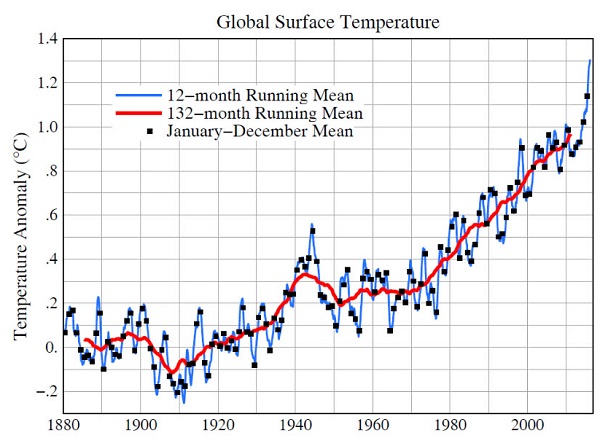James Hansen and Makiko Sato have just released a new temperature graph, which highlights the underlying trend, and is more than a little alarming:

See also his blog post that looks at the implications and what we need to do.
The graph has three main features. First, it is referenced to 1880-1920. Some would argue for 1700-1800 as truly pre-industrial, but they say the figures are less reliable, and the difference is only +0.1°C ± 0.1°C, so in practice it makes no real difference.
Secondly, the blue line is now 12-month running mean, which tends to take out the seasonal cycles. The end of year is marked with the black dots, which are usually down a bit from the year high, so 2016 is likely to end a little below the current 1.3°C. It’s awfully close to 1.5°C, however.
Finally, the red line represents an 11-year running average. This takes out the ‘noise’ due to such things as volcanic eruptions, solar cycles, and the Southern Oscillation Index. They are still in there, but the underlying trend is highlighted.
You can do graphs to highlight the SOI, for example, this one from December 2015:

Or if you want to emphasise the steps, you can do so, like this:

That one stopped at 2012. At 1.3°C now the graph has literally gone off the chart.
Hansen and others have upcoming paper suggesting that the temperature from 1940-45 is exaggerated “because of data inhomogeneity in WW II”.
The story, I think, is one of rapid industrialisation after WW II, where the initial cooling from the smog of burning coal kept the temperature in check for a while. A new coal-fired power station has a negative effect on temperatures for the first seven years. As the aerosols wash out of the atmosphere quickly, the long-lasting CO2 output gradually builds up. Hansen’s graph shows global temperature taking off just after 1970, and the trend looks frightening. The so-called pause from 1998 shows as one slight flattening, amongst several, in the strong and clear upward trend.
Which, of course, is what Hansen is telling us. In a blog post Young People’s Burden he says that emissions and GHG amounts are getting worse. They are in fact accelerating, in spite of all the talk in the UN and elsewhere. Already global temperature is at the level of the Eemian period (130,000 to 115,000 years ago), when sea level was 6-9 meters higher than today. Ice sheet decay responds in terms of centuries, but if we want to avoid significant sea level rise we need to get the temperature back to Holocene levels within the century. Problems with sea level rise have already begun:

Look what we’ve done to the temperature:

Now, Hansen says, we need ‘negative CO2 emissions,’ ie, extraction of CO2 from the air. If we want to do this through bioenergy together with carbon capture and storage the minimal estimated cost is $104 to $570 trillion dollars this century, “with large risks and uncertain feasibility”.
He suggests forestry and sequestering carbon dioxide in soil through revised farming practices.
Other than that, it’s renewables, more efficient energy use, and for Hansen, nukes.
Meanwhile Hansen is supporting litigation brought against the U.S. government by Our Children’s Trust, which argues that the government is violating young peoples’ constitutional rights by failing to act on climate change.
Think Progress has the story:
- The lawsuits, filed in every state as well as against the federal government, are based on a legal theory known as atmospheric trust litigation, developed by University of Oregon law professor Mary Wood. The theory argues that the atmosphere is a crucial natural resource that the government must hold in trust for future citizens. By failing to pass policies that stop climate change, the reasoning goes, the government is failing to preserve the natural environment for future generations.
Hansen, along with his granddaughter, is a party in the Our Children’s Trust litigation in Oregon. That case is currently awaiting a decision from a federal judge as to whether the litigation will be allowed to move forward.

